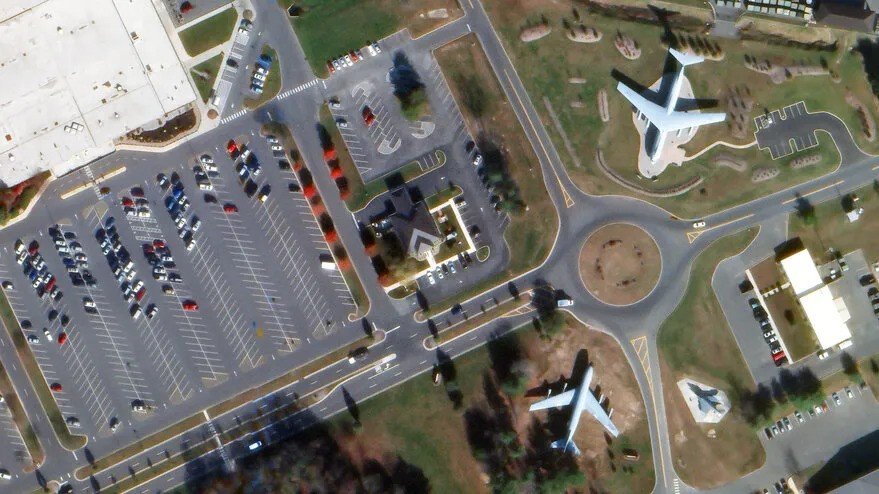Satellite startup Albedo is determined to revolutionize the commercial orbital imagery industry by offering incredibly detailed images from space at a fraction of the cost. The military, which previously had a monopoly on these types of images, had even kept their capabilities a secret until former President Donald Trump leaked a highly classified image back in 2019.
“When Trump tweeted a classified satellite image a few years ago that showed that we could capture 10-centimeter resolution from space, it sparked all this conversation in the commercial industry on how game-changing it would be to have that resolution commercially,” said Albedo’s cofounder and CEO, Topher Haddad, in a recent interview.
Haddad, a former employee at Lockheed Martin working on classified remote sensing satellites for the U.S. government, couldn’t shake off the impact of that conversation. Joined by fellow Lockheed veteran AyJay Lasater and engineer Winston Try, Haddad set out to make their vision a reality by founding Albedo. The goal? To deliver 10-centimeter resolution optical images to commercial customers at a groundbreaking low cost.
(A 10-centimeter resolution essentially means that each pixel in an image covers an area the size of 10 centimeters by 10 centimeters on the ground. In comparison, the biggest optical imagery providers today collect images at a 30-centimeter resolution, which is algorithmically improved to 15 centimeters.)
It’s an ambitious task, especially considering that military satellites capable of capturing images at this resolution have been estimated to cost in the multibillions. But Albedo, based in Denver, has a plan to drastically reduce costs – not through major innovations in optics, but through their unique satellite bus platform designed to operate in very low Earth orbit (VLEO). As Haddad puts it, “that is where the VLEO technology lives.”
Unlike most Earth observation companies operating in low Earth orbit (LEO) at an altitude of approximately 2,000 kilometers, Albedo is targeting the lesser-known VLEO, which ranges from 250 to 450 kilometers. The company has designed a fully optimized satellite bus for this environment, from its guidance, navigation, and control (GNC) system to its solar arrays and mission planning process. The result? An average of four years in orbit for each satellite.
This last detail is crucial. While VLEO may offer some advantages, such as less crowding and more protection from radiation, the closer proximity to Earth also means a higher atmospheric drag for objects in this orbit. But Albedo’s satellites circumvent this issue by being dense and heavy, as well as utilizing an efficient electric propulsion system to counteract the drag.
Haddad states that the greatest technical challenges lie in the robotics, control, and attitude systems. He explains, “There’s three categories: there’s stability, which is making sure your picture isn’t blurry. There’s agility, so being able to rapidly repoint at different targets that you’re trying to image as you’re passing over very quickly [… ] And then there’s accuracy, knowing exactly where you’re pointed, which is related to stability and agility and also gives you that geolocation metric that certain customers care a lot about.”
“All of those things at 10-centimeter resolution are just inherently very hard because the angle from a single pixel is smaller than it would be for a thirty centimeter or fifty centimeter or three meter. So any specific disturbance is going to impact the 10-centimeter pixel much more than a thirty centimeter pixel. Then you take that and you fly in VLEO, where the satellites are moving even faster around the Earth, there’s torque from the atmosphere – all those things just pose an even bigger challenge for GNC.”
Investors have been quick to rally behind Albedo’s groundbreaking vision. In September 2022, less than a year after completing Y Combinator, the company announced that it had raised $48 million in Series A funding. Now, with an up round valuation, Albedo has closed $35 million in Series A-1 financing.
The potential use cases for the company’s images are numerous, ranging from commercial to defense purposes. This is reflected in their diverse investor group, which includes funds such as Bill Gates’ Breakthrough Energy Ventures and defense tech-focused Shield Capital. Leading this latest round of financing is Standard Investments, the investing arm of industrial giant Standard Industries. New investors Booz Allen Ventures, Cubit Capital, and Bill Perkins also participated, as well as existing investors like Breakthrough and Shield, Initialized Capital, Y Combinator, Giant Step Capital, Republic Capital, and others. With the latest capital infusion, Albedo has now raised a total of $97 million.
Currently, Albedo is working towards the launch of its first commercial satellite in the first half of 2025. Haddad declined to provide a timeline beyond that, but did mention that their next goal would be to launch a block of six satellites, providing a daily global revisit rate. Ultimately, the company hopes to have a full constellation of 24 satellites, offering five revisits per day.








